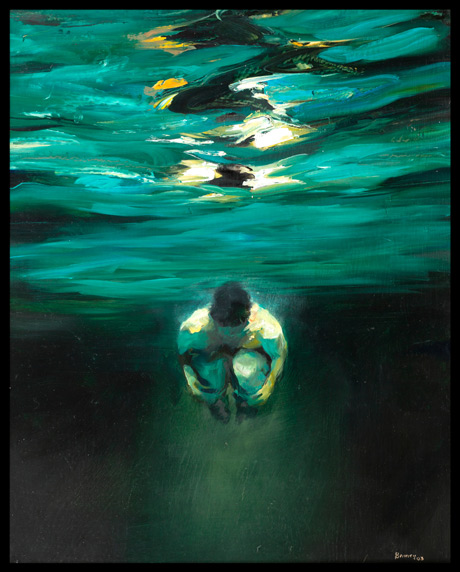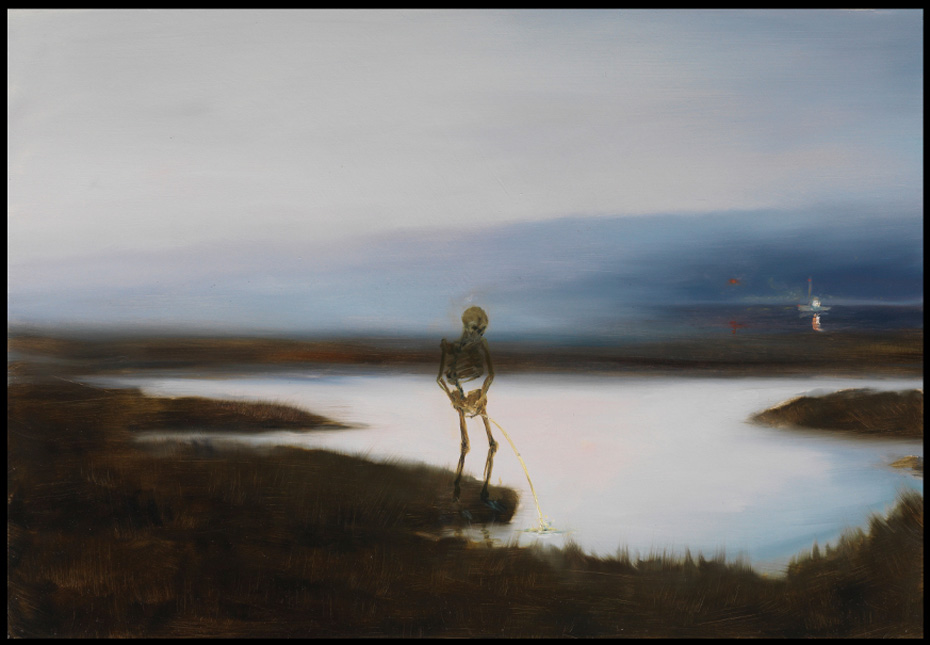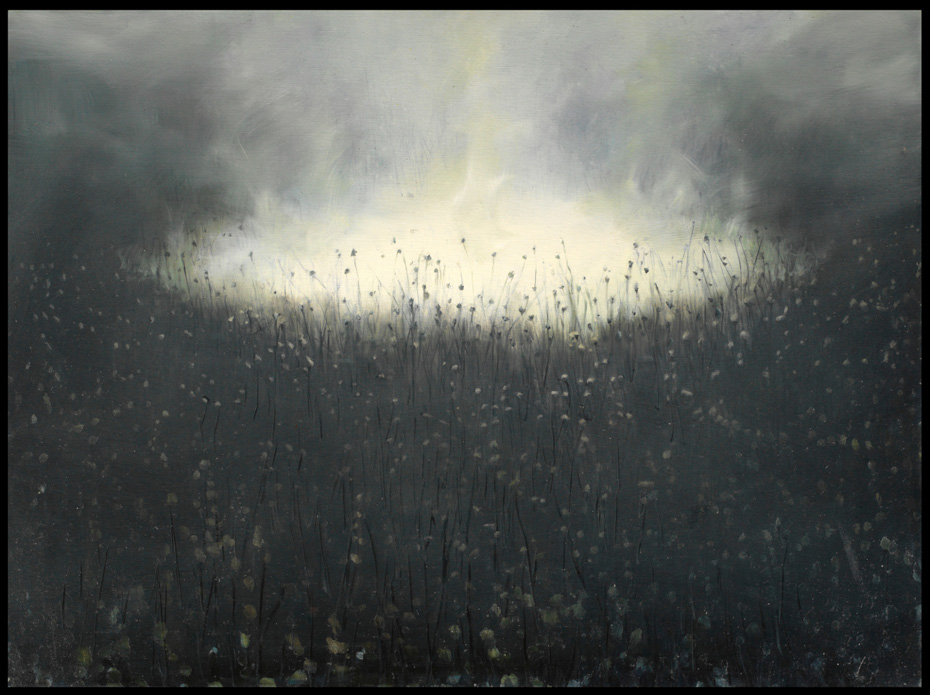- Kat Phan talks to the British artist about his show at Somerset House, his fascination with levitation and his passion for cooking
 Levetation, oil on panel, 2005
Levetation, oil on panel, 2005The Deadhouse, situated just beneath London Somerset House’s fountain courtyard is an atmospheric series of hidden, dimly lit alcoves and vaults. This intimate space provides the perfect setting for the works of British artist Paul Benney produced during his tenure as a resident artist at Somerset House. As the overarching title of the exhibition suggests, Night Paintings were produced in the early hours of the morning, with Benney in somewhat of a dream-like state. The result is a mesmerising body of work, infused with themes of isolation, love and loss.
On viewing Benney’s paintings, one thing that is unequivocal is how intense they are. As you enter the alcoves, your eyes are immediately drawn to the illuminated artworks that hang on the bare-brick walls, eliciting a concoction of feelings; sombre, haunted, spiritual, not necessarily in that order. In the main vault — also home to gravestones of 17th century French nobility, adding to the ever-so-slightly eerie effect — I was particularly transfixed by a set of paintings: The Tenant (2012), where a naked man stands embalmed in a pale green mist, with a faint source of light behind him. There are very few details visible in terms of expression and anatomy yet his posture suggests he is open and vulnerable; his outstretched hand emerging from the painting appearing almost life-like.

 In the alcove opposite, a woman standing sideways in Her Ghost (2012) is shielding her face, as if to reject the man reaching out to her. In both paintings, the facial expressions are veiled yet the revealing body language provides the viewer with a voyeuristic, speculative insight into the state of their relationship. Combined with the haunting surroundings, it is impossible not to feel moved.
In the alcove opposite, a woman standing sideways in Her Ghost (2012) is shielding her face, as if to reject the man reaching out to her. In both paintings, the facial expressions are veiled yet the revealing body language provides the viewer with a voyeuristic, speculative insight into the state of their relationship. Combined with the haunting surroundings, it is impossible not to feel moved.
Inspired by Goya, Rembrandt and Velázquez, Benney’s portraiture and allegorical work, Benney currently lives in London. His work can be found within collections at The Metropolitan Museum of Art (New York), The National Portrait Gallery (London) and the National Gallery, Canberra (Australia), The Eli Broad Foundation (Los Angeles) and The Rothschild Foundation. Among his private commissions, Benney has produced work for the Marquis of Bath, Lord Rothschild, Paul Getty III, the Sitwell family, the Duke and Duchess of Bedford, Lord Sainsbury of Preston Candover and Mick Jagger.
Above: Pissing on Death, oil on wood, 2012Port met with the refreshingly down to earth and charismatic artist to talk about the creative process behind his Night Paintings, the factors that influenced his decision on where to hold his latest exhibition, and the meditative effects of painting.
Levitation appears to be a common theme in your paintings. What was your inspiration for this?
Often I dream of levitating and at the point of waking up, I think to myself “I can do that, I must give that a try…” If I’ve painted something, that image has arrived without any prior thought of what it’s called or what it means. It has been formed from hours of sitting in the studio. The titles always come after the paintings. For example, for Sometimes I Dream of You (2012), I put the lilac line in and the tornado and it started to sing… and then it became a ‘levitation’ image and part of a series. I hate doing it the other way around… that never works.


From what I understand, it’s the first time the Deadhouse has been used for an exhibition of this kind. How did this come about?Well, being the artist in residence here, I was poking around, looking for a space, which would suit the show. Initially I’d been thinking about one of the Terrace Rooms upstairs but then I found the Deadhouse, which was used for storage but I’d known it had been used for a sound instillation at one point. It was full of stuff, very damp and parts of it were rotting, but I thought we could persuade the directors to put on the show here. We got some decent lighting, a new floor, dried it out a bit and then we had a space.
The venue itself is very dark, eerie and spiritual, which lends itself very well to the visual aesthetic of your work. How important do you think the exhibition space is in relation to the visitor’s experience?
In the white wall galleries, my work tends to bleach out a bit and I’m never that happy with them in spaces like that. I prefer it if there’s embedded age in the walls; it complements the atmosphere that the works give off. My last show was in a mortuary in West London that I used as a studio, which I turned into a gallery for a few weeks.
Above: Into the Morning, oil on wood, 2008The one before that was an old abattoir in Portobello. Before that, I exhibited in a multi-story car park in Manhattan that was also derelict. People love to come to unusual places, it makes them stop and contemplate the work more than if they’re shunted around some corporate gallery space. They don’t have the opportunity to contemplate because they feel as if they have to look around quickly and get out. I find this kind of exhibition in a space like the Deadhouse with all its bunkers, coalholes and alcoves, with paintings given their own space, requires you to really slow down… You’re invited in, and it’s up to you whether you want to accept the invitation.
All of the subjects in your paintings appear to be in a state of transition, in a state of flux. Was this intentional?
Well the way that I access my sense of self is to get myself into a state of mind where I’m not filtering very much and combinations of images bubble up which I can either accept or reject. The ones that I accept often fall into this category of transition. I’m in transition, we’re all in transition, all the time. In my view, if you get stuck somewhere, that’s bad. You want to be in a state of flux so you can move around.

- What is usually the stimulus for you to get into this state of mind?
I just start painting and it becomes the way I start thinking; the act of painting enhances the alpha state. It’s like a cyclical, bio-feedback situation. Once I’m in it, I can go all evening. It’s very much like meditation; you start on one level and go deeper and deeper, and that’s how it is with painting too. The only difference is that at the end, you have a physical object. Sometimes I go home and my kids will say: “Daddy you look so much younger!” and it’s because I’d been in this sort of meditative state for hours and all of the stress would have escaped from my face.
What other things drive you in life, other than painting and music?
If I couldn’t play the piano or get in the studio, I would feel lost. I wouldn’t know what to do. When I get out of the studio, often the feeling to create is still there, so I go to the kitchen, I enjoy cooking. I think it’s the act of engagement that I find appealing. The idea of not being able to engage fully with whatever activity it is that you’re doing is really awful, that would be hell.
Night Paintings by Paul Benney is showing at Somerset House until 9 Dec
Subscribe to Port Magazine annually and receive each issue to your door.
Get PORT in print



